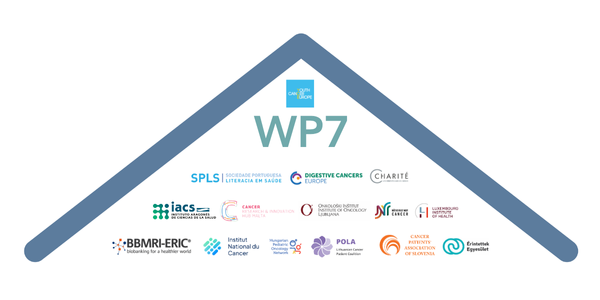At a glance
WP7 focuses on ensuring meaningful engagement of cancer patients, survivors, relatives, and caregivers in the development and implementation of the cancer information portals.
The team

WP7 is led by YCE and contributed to by IACS, HUPON, LIH, INC, CRIHM, SPLS, OIL, CPAS, BIH/CHA, BBMRI-ERIC, DiCE, POLA, ERT, NMC
The task
WP7 is structured around four key tasks:
Task 7.1: Requirements Gathering and Systemic Engagement
Led by YCE (a pan-European patient organisation), this task mobilises 15 consortium members to systematically collect and analyse input from end-users through focus groups and surveys. Regular consultation sessions and design-thinking workshops will identify key needs and concerns.
Task 7.2: Content Review and Patient-Centred Validation
SUHCC (Comprehensive Cancer Centre in Sweden) leads the review of both static and AI-generated content to ensure clarity, relevance, and accessibility for diverse end-users. Feedback from WP7 participants will be integrated, with a focus on lay-language, cultural sensitivity, and individual preferences.
Task 7.3: Validation of EU-CIP Approach
DiCE (a pan-European patient organisation) coordinates the validation process, ensuring that patient and caregiver insights are systematically incorporated into project planning and execution.
Task 7.4: Patient-Centred Participation in Implementation
Piloting sessions will involve end-users in testing and scaling up cancer information portals, starting with a pilot in Lithuania and led by POLA (a national patient organisation). Feedback from these sessions will drive iterative improvements, ensuring that cancer information portals are accessible, user-friendly, and relevant.
Expected Results of WP7:
- Comprehensive mapping and prioritisation of end-user needs and requirements, validated, patient-friendly content and information algorithms, tailored to diverse user backgrounds and clinical profiles.
- Systematic integration of end-user feedback into all relevant work packages, resulting in a cohesive and responsive EU-CIP structure.
- Successful piloting and iterative refinement of national/regional cancer information portals, leading to improved usability, accessibility, and relevance for end-users.
- Documented impact of patient-driven recommendations, with clear evidence of enhanced user satisfaction, engagement, and trust in the EU-CIP platform.
